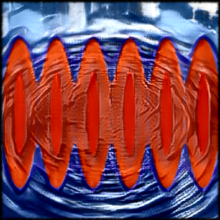A supersolid is a paradoxical state of matter that combines the spatial ordering of a solid with the superfluid flow of atoms without friction. In the present publication “Transient Supersolid Properties in an Array of Dipolar Quantum Droplets" in Physical Review X, we report on the observation of two hallmark properties of such a supersolid state in array of multiple quantum droplets.
In particular, we study theoretically and experimentally the behavior of an elongated dipolar Bose-Einstein condensate in the regime of quantum-mechanical stabilization by beyond-mean-field effects. Similar to our previous publication [Phys. Rev. A 96, 053630 (2017)] we demonstrate that self-organized, supersolid ground states are predicted in the framework of the extended Gross-Pitaevskii theory. For these supersolid states the spatial ordering is created by the intrinsic interactions of the particles, which therefore allows for phonon excitations in the system.
In contrast to our previous publication, we now show that it is possible to dynamically create states very close to the actual supersolid ground state of the system in a narrow range of the interaction strength. This new phase, in which the quantum droplets are immersed in a condensate background, exists close to the phase transition between regular Bose-Einstein condensate and quantum droplets. The condensate background can therefore act as a link between different droplets and establish a robust phase coherence throughout the system. We experimentally probe these states by directly observing two hallmarks of a supersolid state - the spatial ordering into a droplet array, as well as robust phase coherence across the droplet array.
Moving forward, we will need to prove the actual superfluidity of the state, attempt to extend its lifetime, as well as probe its collective excitations.


